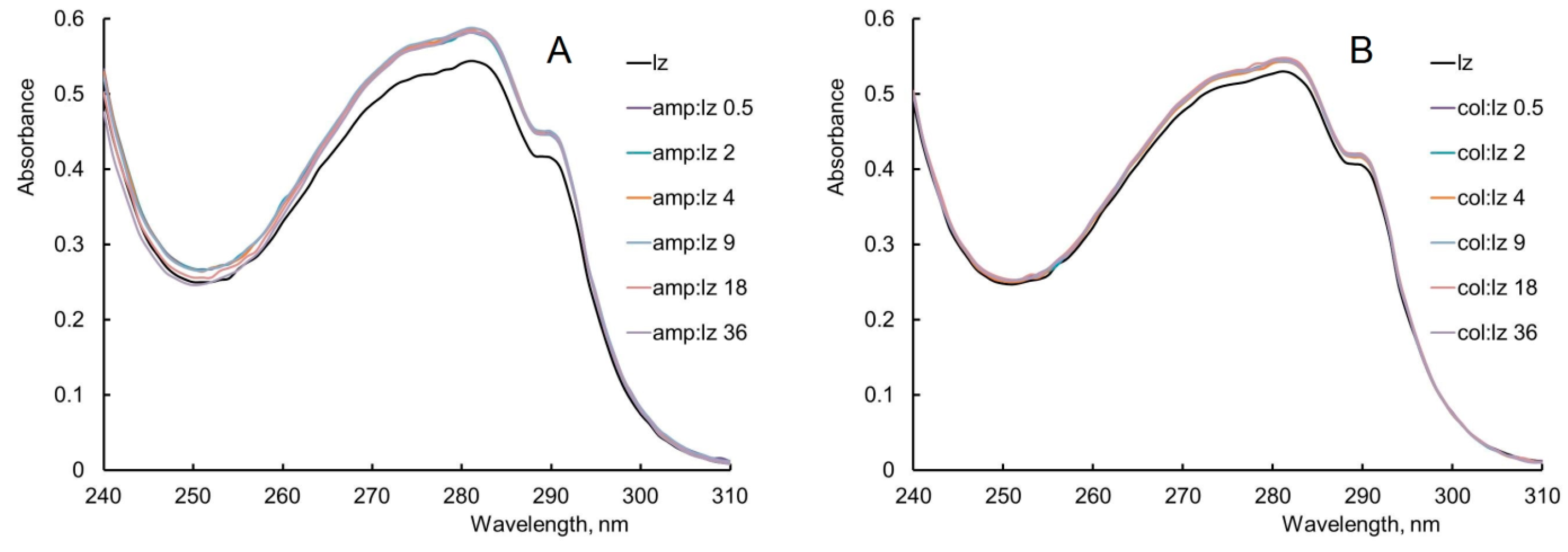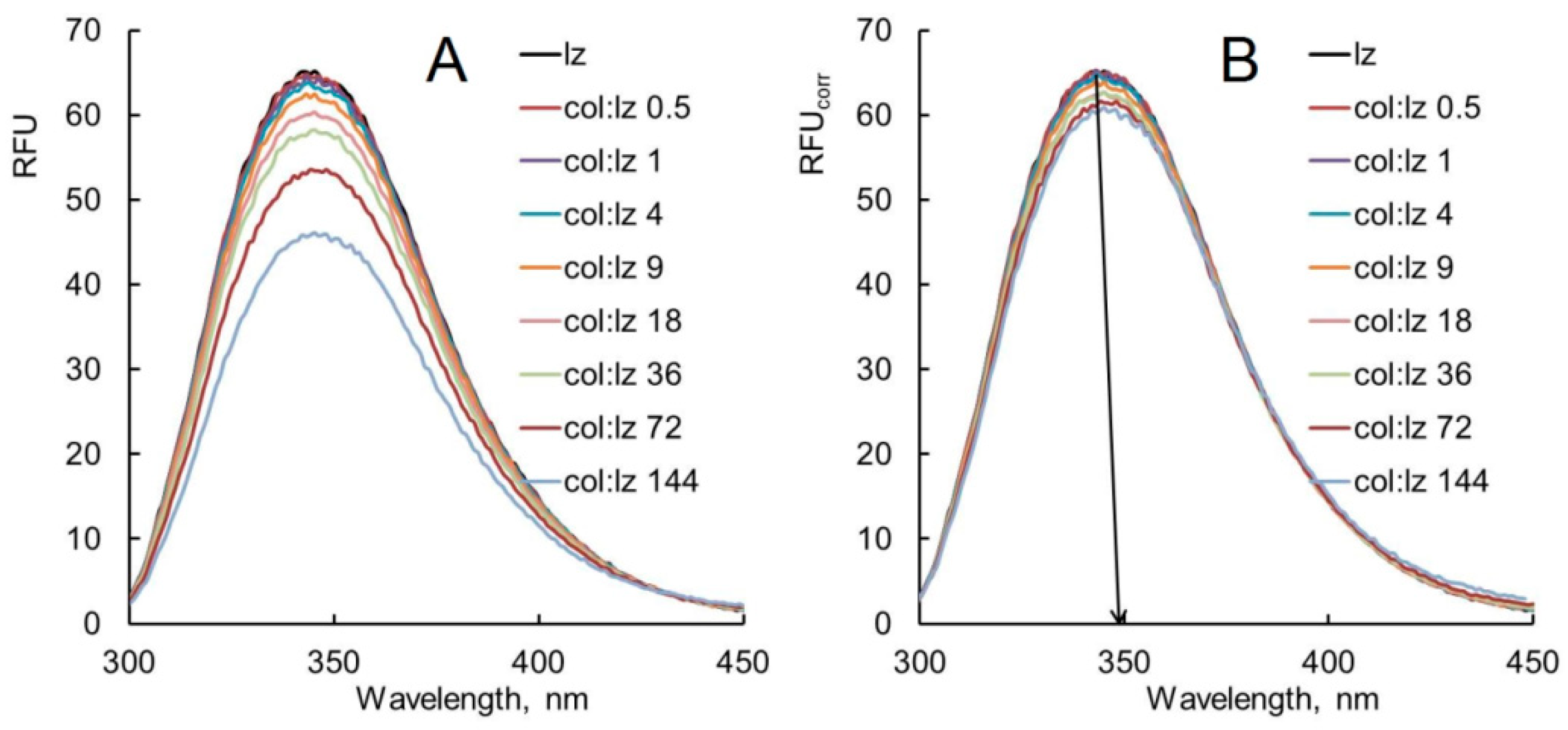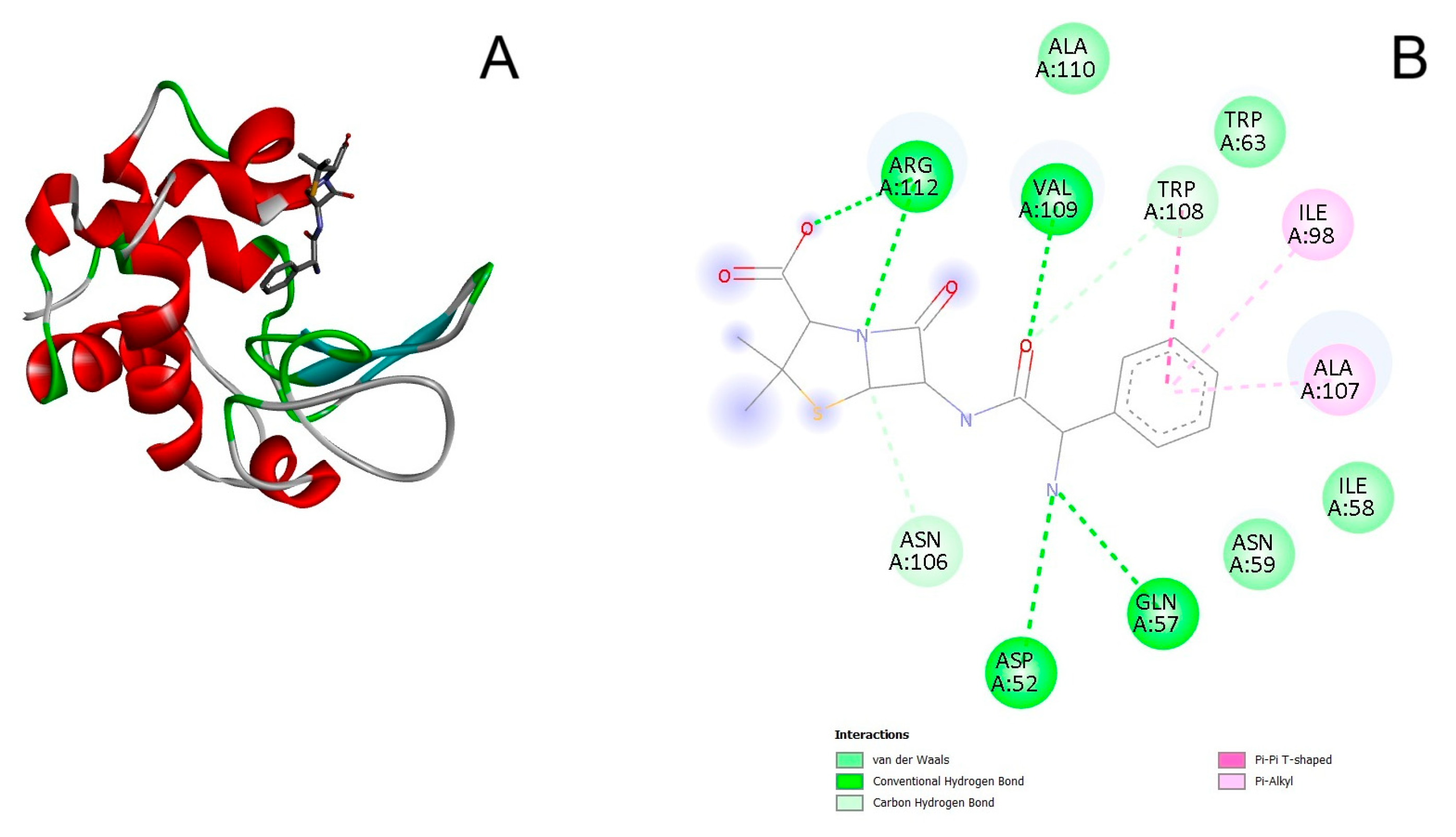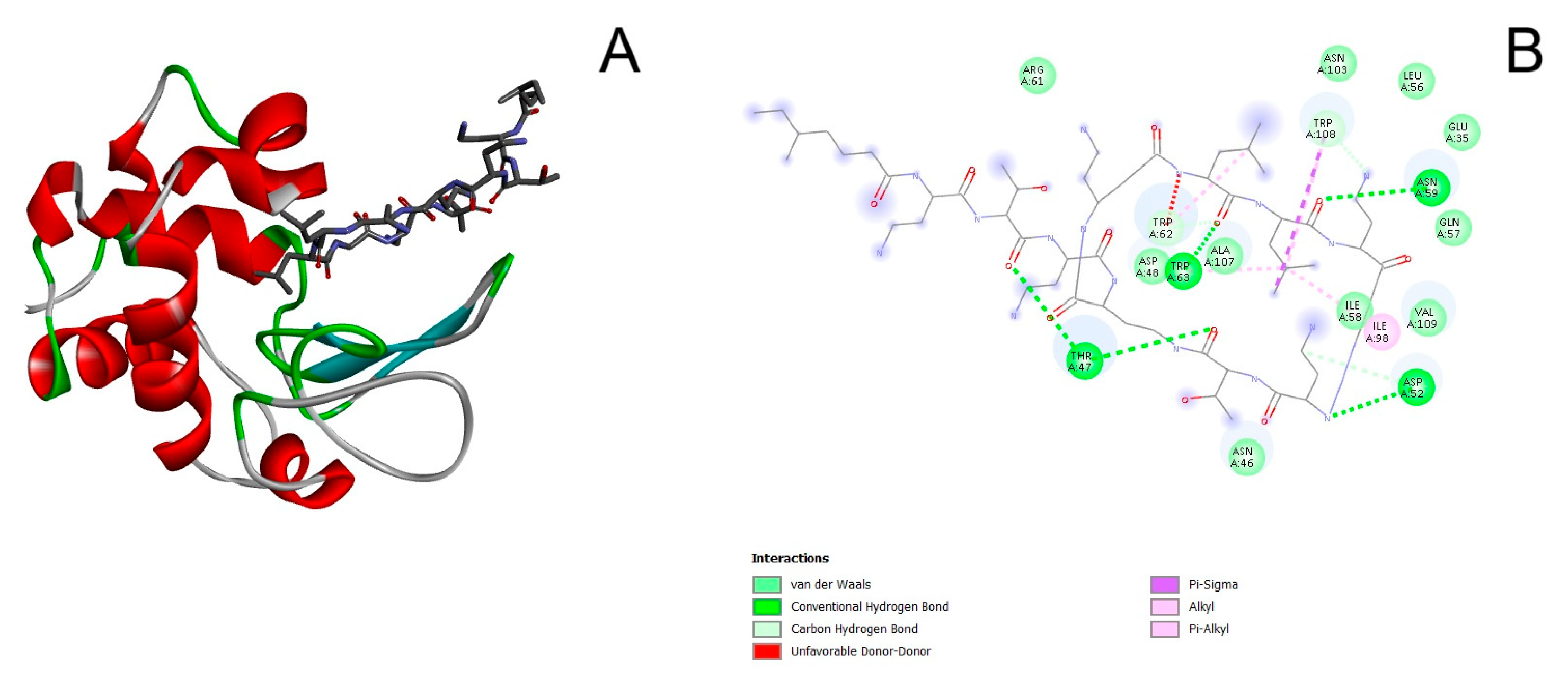The Specifics of an Interaction Between Hen Egg White Lysozyme and Antibiotics
Abstract
1. Introduction
2. Materials and Methods
2.1. Reagents
2.2. Preparation of Lysozyme Complexes with Antibiotics
2.3. The Turbidimetric Identification of Lysozyme Activity
2.4. Fluorescence Measurements
2.5. UV–Vis Spectroscopy
2.6. CD Spectroscopy
2.7. Molecular Docking Approaches
3. Results and Discussion
3.1. The Study of the Interaction of Lysozyme with Antibiotics Using UV–Vis Spectroscopy
3.2. The Study of the Interaction of Lysozyme with Antibiotics by Fluorescence Measurements
3.3. The Study of the Interaction of Lysozyme with Antibiotics by Circular Dichroism Spectroscopy
3.4. The Study of the Effect of Antibiotics on the Kinetic Parameters of Lysozyme
3.5. Molecular Docking
4. Conclusions
Supplementary Materials
Funding
Data Availability Statement
Conflicts of Interest
Abbreviations
| PBS | phosphate-buffered saline (137 mM NaCl, 2.7 mM KCl, 10 mM Na2HPO4, 1.8 mM KH2PO4) |
| UV | ultraviolet |
| CD | circular dichroism |
| lz | hen egg white lysozyme |
| amp | ampicillin |
| col | colistin |
References
- Wang, L.; Zhang, W.; Shao, Y.; Zhang, D.; Guo, G.; Wang, X. Analytical methods for obtaining binding parameters of drug–protein interactions: A review. Anal. Chim. Acta 2022, 1219, 340012. [Google Scholar] [CrossRef] [PubMed]
- Vuignier, K.; Schappler, J.; Veuthey, J.-L.; Carrupt, P.-A.; Martel, S. Drug–protein binding: A critical review of analytical tools. Anal. Bioanal. Chem. 2010, 398, 53–66. [Google Scholar] [CrossRef] [PubMed]
- Hage, D.; Jackson, A.; Sobansky, M.; Schiel, J.E.; Yoo, M.J.; Joseph, K.S. Characterization of drug-protein interactions in blood using high-performance affinity chromatography. J. Sep. Sci. 2009, 32, 835–853. [Google Scholar] [CrossRef]
- Fleming, A. On a remarkable bacteriolytic element found in tissues and secretions. Proc. R. Soc. Lond. B 1922, 93, 306–317. [Google Scholar] [CrossRef]
- Oliver, W.T.; Wells, J.E. Lysozyme as an alternative to growth promoting antibiotics in swine production. J. Anim. Sci. Biotechnol. 2015, 6, 35. [Google Scholar] [CrossRef]
- Chen, T.; Tan, L.; Hu, N.; Dong, Z.; Hu, Z.; Jiang, Y.; Chen, P.; Pan, M.; Lu, C. C-lysozyme contributes to antiviral immunity in Bombyx mori against nucleopolyhedrovirus infection. J. Insect Physiol. 2018, 108, 54–60. [Google Scholar] [CrossRef]
- Blake, C.C.; Koenig, D.F.; Mairv, G.A.; North, A.C.; Phillips, D.C.; Sarma, V.R. Structure of hen egg–white lysozyme: A three–dimensional Fourier synthesis at 2 Å resolution. Nature 1965, 206, 757–761. [Google Scholar] [CrossRef]
- Phillips, D.C. The hen egg white lysozyme molecule. Proc. Natl. Acad. Sci. USA 1967, 57, 484–495. [Google Scholar] [CrossRef]
- Kamatari, Y.O.; Yamada, H.; Akasaka, K.; Jones, J.A.; Dobson, C.M.; Smith, L.J. Response of native and denatured hen lysozyme to high pressure studied by 15N/1H NMR spectroscopy. Eur. J. Biochem. 2001, 268, 1782–1793. [Google Scholar] [CrossRef]
- Yang, J.J.; van den Berg, B.; Pitkeathly, M.; Smith, L.J.; Bolin, K.A.; Keiderling, T.A.; Redfield, C.; Dobson, C.M.; Radford, S.E. Native-like secondary structure in a peptide from the a-domain of hen lysozyme. Fold Des. 1996, 1, 473–484. [Google Scholar] [CrossRef] [PubMed]
- Williams, M.A.; Thornton, J.M.; Goodfellow, J.M. Modelling protein unfolding: Hen egg-white lysozyme. Prot. Eng. 1997, 10, 895–903. [Google Scholar] [CrossRef]
- Held, J.; van Smaalen, S. The active site of hen egg-white lysozyme: Flexibility and chemical bonding. Acta Crystallogr. D Biol. Crystallogr. 2014, 70, 1136–1146. [Google Scholar] [CrossRef]
- Cunningham, F.E.; Proctor, V.A.; Goetsch, S.J. Egg-white lysozyme as a food preservative—An overview. World’s Poult. Sci. J. 1991, 47, 141–163. [Google Scholar] [CrossRef]
- Ragland, S.A.; Criss, A.K. From bacterial killing to immune modulation: Recent insights into the functions of lysozyme. PLoS Path. 2017, 13, e1006512. [Google Scholar] [CrossRef]
- Małaczewska, J.; Kaczorek-Łukowska, E.; Wójcik, R.; Siwicki, A.K. Antiviral effects of nisin, lysozyme, lactoferrin and their mixtures against bovine viral diarrhoea virus. BMC Vet. Res. 2019, 15, 318. [Google Scholar] [CrossRef]
- Lee, W.; Ku, S.-K.; Na, D.H.; Bae, J.-S. Anti-inflammatory effects of lysozyme against HMGB1 in human endothelial cells and in mice. Inflammation 2015, 38, 1911–1924. [Google Scholar] [CrossRef]
- Filatova, L.Y.; Emelianov, G.P.; Balabushevich, N.G.; Klyachko, N.L. Supramolecular assemblies of mucin and lysozyme: Formation and physicochemical characterization. Proc. Biochem. 2022, 113, 97–106. [Google Scholar] [CrossRef]
- Filatova, L.Y.; Balabushevich, N.G.; Klyachko, N.L. A physicochemical, structural, microbiological and kinetic study of hen egg white lysozyme in complexes with alginate and chitosan. Biocatal. Biotransform. 2022, 40, 327–340. [Google Scholar] [CrossRef]
- Ceron, A.A.; Nascife, L.; Norte, S.; Costa, S.A.; Oliveira do Nascimento, J.H.; Morisso, F.D.P.; Baruque-Ramos, J.; Oliveira, R.C.; Costa, S.M. Synthesis of chitosan-lysozyme microspheres, physicochemical characterization, enzymatic and antimicrobial activity. Int. J. Biol. Macromol. 2021, 185, 572–581. [Google Scholar] [CrossRef] [PubMed]
- Khan, J.M.; Malik, A.; Ahmed, M.Z. Bimolecular interaction of zwitterionic surfactant with hen egg white lysozyme (HEWL): A biophysical study. J. King Saud Univ. Sci. 2022, 34, 101674. [Google Scholar] [CrossRef]
- Fan, J.-B.; Chen, J.; Liang, Y. Oxidative refolding of reduced, denatured lysozyme in AOT reverse micelles. J. Colloid Interface Sci. 2008, 322, 95–103. [Google Scholar] [CrossRef]
- Ali, M.S.; Waseem, M.; Subbarao, N.; Al-Lohedan, H.A. Dynamic interaction between lysozyme and ceftazidime: Experimental and molecular simulation approaches. J. Mol. Liq. 2021, 328, 115412. [Google Scholar] [CrossRef]
- Wang, Z.; Tan, X.; Chen, D.; Yue, Q.; Song, Z. Study on the binding behavior of lysozyme with cephalosporin analogues by fluorescence spectroscopy. J. Fluoresc. 2009, 19, 801–808. [Google Scholar] [CrossRef]
- Li, Z.; Zhang, L.; Lu, H.; Chen, X.; Zhou, Y.; Wang, H.; Liu, Y.; Hao, C. Molecular insights into the interaction between lysozyme and cephalosporins: From multi-spectral experiments to computational simulations. J. Mol. Liq. 2023, 392, 123517. [Google Scholar] [CrossRef]
- Han, R.; Liu, B.; Li, G.; Zhang, Q. Investigation on the interaction of cefpirome sulfate with lysozyme by fluorescence quenching spectroscopy and synchronous fluorescence spectroscopy. Luminescence 2016, 31, 580–586. [Google Scholar] [CrossRef] [PubMed]
- Ali, M.S.; Waseem, M.; Subbarao, N.; Alahamed, A.N.; Al-Lohedan, H.A. Probing the interaction of cephalosporin antibiotic “cefoperazone” with lysozyme using spectroscopic and in silico methods: Effect of paracetamol on binding. Int. J. Biol. Macromol. 2023, 252, 126568. [Google Scholar] [CrossRef]
- Jiang, C.; Ting Wang, T. Study of the interactions between tetracycline analogues and lysozyme. Bioorg. Med. Chem. 2004, 12, 2043–2047. [Google Scholar] [CrossRef]
- Chi, Z.; Liu, R. New insights into the characterization of the binding of tetracycline analogues with lysozyme: A biophysical study. Chemosphere 2012, 86, 92–97. [Google Scholar] [CrossRef]
- Li, X.; Liu, X.; Zhao, J.; Sun, Y.; Liang, Y.; Hu, Q. Formation Mechanism and Antibacterial Activity of Natural Antimicrobial Lysozyme with Antibiotics Doxycycline and Tigecycline. J. Mol. Biol. 2025, 437, 169304. [Google Scholar] [CrossRef]
- Subramanian, M.; Sheshadri, B.S.; Venkatappa, M.P. Interaction of lysozyme with antibiotics–binding of penicillins to lysozyme. J. Biosci. 1983, 5, 331–338. [Google Scholar] [CrossRef]
- Rial, R.; González-Durruthy, M.; Liu, Z.; Ruso, J.M. Conformational binding mechanism of lysozyme induced by interactions with penicillin antibiotic drugs. J. Mol. Liq. 2022, 358, 119081. [Google Scholar] [CrossRef]
- Pang, X.; Sun, L.; Wan, J.; Xu, X.; Wei, X.; Hua, R.; Wang, Y.; Zhu, M.; Yang, X. New insights into the binding mechanism of lysozyme by 2-sulfanilamido-4-methylpyrimidine and 3-sulfanilamido-5-methylisoxazole: Density function theory, multispectral techniques and molecular docking. J. Lumin. 2023, 255, 119559. [Google Scholar] [CrossRef]
- Khalil, A.; Kashif, M. Interaction studies of levofloxacin with human lysozyme in a ternary complex using multispectroscopic and computational analysis: A circular dichroism method for the quantitation of levofloxacin. J. Mol. Liq. 2023, 370, 121023. [Google Scholar] [CrossRef]
- Fang, Q.; Guo, C.; Wang, Y.; Liu, Y. The study on interactions between levofloxacin and model proteins by using multi-spectroscopic and molecular docking methods. J. Biomol. Struct. Dyn. 2018, 36, 2032–2044. [Google Scholar] [CrossRef]
- Parveen, S.; Ali, M.S.; Al-Lohedan, H.A.; Hoti, N.; Tabassum, S. Molecular interaction of lysozyme with therapeutic drug azithromycin: Effect of sodium dodecyl sulfate on binding profile. Int. J. Biol. Macromol. 2023, 242, 124844. [Google Scholar] [CrossRef]
- Ding, F.; Zhao, G.; Huang, J.; Sun, Y.; Zhang, L. Fluorescence spectroscopic investigation of the interaction between chloramphenicol and lysozyme. Eur. J. Med. Chem. 2009, 44, 4083–4089. [Google Scholar] [CrossRef]
- Ivashkiv, E. Ampicillin. In Analytical Profiles of Drug Substances; Florey, K., Ed.; Academic Press, Inc.: New York, NY, USA, 1973; Volume 2, pp. 1–61. [Google Scholar]
- Bereda, G. Clinical pharmacology of ampicillin. J. Pharm. Res. Rep. 2022, 3, 1–3. [Google Scholar] [CrossRef]
- Tarannuma, N.; Khatoon, S.; Dzantiev, B.B. Perspective and application of molecular imprinting approach for antibiotic detection in food and environmental samples: A critical review. Food Control 2020, 118, 107381. [Google Scholar] [CrossRef]
- Tótoli, E.G.; Salgado, H.R.N. Development and validation of the quantitative analysis of ampicillin sodium in powder for injection by Fourier-transform infrared spectroscopy (FT-IR). Phys. Chem. 2012, 2, 103–108. [Google Scholar] [CrossRef]
- Bialvaei, A.Z.; Samadi, K.H. Colistin, mechanisms and prevalence of resistance. Curr. Med. Res. Opin. 2015, 31, 707–721. [Google Scholar] [CrossRef] [PubMed]
- Biswas, S.; Brunel, J.-M.; Dubus, J.-C.; Reynaud-Gaubert, M.; Rolain, J.-M. Colistin: An update on the antibiotic of the 21st century. Expert Rev. Anti. Infect. Ther. 2012, 10, 917–934. [Google Scholar] [CrossRef]
- Trimble, M.J.; Mlynarcik, P.; Kolar, M.; Hancock, R.E.W. Polymyxin: Alternative mechanisms of action and resistance. Cold Spring Harb. Perspect. Med. 2016, 6, a025288. [Google Scholar] [CrossRef] [PubMed]
- Finking, R.; Marahiel, M.A. Biosynthesis of nonribosomal peptides. Annu. Rev. Microbiol. 2004, 58, 453–488. [Google Scholar] [CrossRef]
- Sabnis, A.; Lh Hagart, K.; Klöckner, A.; Becce, M.; Evans, L.E.; Furniss, R.C.D.; Ai Mavridou, D.; Murphy, R.; Stevens, M.M.; Davies, J.C.; et al. Colistin kills bacteria by targeting lipopolysaccharide in the cytoplasmic membrane. eLife 2021, 10, e65836. [Google Scholar] [CrossRef]
- Breazeale, S.D.; Ribeiro, A.A.; McClerren, A.L.; Raetz, C.R.H. A formyltransferase required for polymyxin resistance in Escherichia coli and the modification of lipid A with 4-Amino-4-deoxy-L-arabinose. Identification and function of UDP-4-deoxy-4-formamido-L-arabinose. J. Biol. Chem. 2005, 280, 14154–14167. [Google Scholar] [CrossRef] [PubMed]
- Muller, C.; Plésiat, P.; Jeannot, K. A two-component regulatory system interconnects resistance to polymyxins, aminoglycosides, fluoroquinolones and beta-lactams in Pseudomonas aeruginosa. Antimicrob. Agents Chemother. 2011, 55, 1211–1221. [Google Scholar] [CrossRef] [PubMed]
- Cornish–Bowden, A. Fundamentals of Enzyme Kinetics; Portland Press: London, UK, 1995; pp. 1–75. [Google Scholar]
- Lakowicz, J.R. Principles of Fluorescence Spectroscopy; Springer: Dordrecht, The Netherlands, 2006; pp. 1–381. [Google Scholar]
- Bohm, G.; Muhr, R.; Jaenicke, R. Quantitative analysis of protein far UV circular dichroism spectra by neural networks. Protein Eng. 1992, 5, 191–195. [Google Scholar] [CrossRef]
- Khan, J.M.; Malik, A.; Ahmed, A.; Rehman, M.T.; AlAjmi, M.F.; Khan, R.H.; Fatima, S.; Alamery, S.F.; Abdullah, E.M. Effect of cetyltrimethylammonium bromide (CTAB) on the conformation of a hen egg white lysozyme: A spectroscopic and molecular docking study. Spectrochim. Acta A Mol. Biomol. Spectrosc. 2019, 219, 313–318. [Google Scholar] [CrossRef]
- Imoto, T.; Forster, L.S.; Rupley, J.A.; Tanaka, F. Fluorescence of lysozyme: Emissions from tryptophan residues 62 and 108 and energy migration. Proc. Natl. Acad. Sci. USA 1971, 69, 1151–1155. [Google Scholar] [CrossRef]
- Biswas, B.; Muttathukattil, A.N.; Reddy, G.; Singh, P.C. Contrasting effects of guanidinium chloride and urea on the activity and unfolding of lysozyme. ACS Omega 2018, 3, 14119–14126. [Google Scholar] [CrossRef]
- Eftink, M.R. Fluorescence quenching reactions. In Biophysical and Biochemical Aspects of Fluorescence Spectroscopy; Dewey, T.G., Ed.; Springer: Dordrecht, The Netherlands, 1991; pp. 1–41. [Google Scholar]
- Ding, H.; Wu, X.; Pan, J.; Hu, X.; Gong, D.; Zhang, G. New insights into the inhibition mechanism of betulinic acid on α-glucosidase. J. Agric. Food Chem. 2018, 66, 7065–7075. [Google Scholar] [CrossRef]
- Szkudlarek, A.; Wilk, M.; Maciazek-Jurczyk, M. In Vitro Investigations of Acetohexamide Binding to Glycated Serum Albumin in the Presence of Fatty Acid. Molecules 2020, 25, 2340. [Google Scholar] [CrossRef]
- Geethanjali, H.S.; Nagaraja, D.; Melavanki, R.M.; Kusanur, R.A. Fluorescence quenching of boronic acid derivatives by aniline in alcohols—A Negative deviation from Stern–Volmer equation. J. Lumin. 2015, 67, 216–221. [Google Scholar] [CrossRef]
- Matyus, L.; Szollosi, J.; Jenei, A. Steady-state fluorescence quenching applications for studying protein structure and dynamics. Photochem. Photobiol. B Biol. 2006, 83, 223–236. [Google Scholar] [CrossRef]
- Saha, S.; Chowdhury, J. Binding interaction of juglone with lysozyme: Spectroscopic studies aided by in silico calculations. J. Photochem. Photobiol. B Biol. 2019, 193, 89–99. [Google Scholar] [CrossRef]
- Sood, D.; Kumar, N.; Singh, A.; Tomar, V.; Dass, S.K.; Chandra, R. Deciphering the binding mechanism of noscapine with lysozyme: Biophysical and chemoinformatic approaches. ACS Omega 2019, 4, 16233–16241. [Google Scholar] [CrossRef]
- Torrens, G.; Pérez-Gallego, M.; Moya, B.; Munar-Bestard, M.; Zamorano, L.; Cabot, G.; Blázquez, J.; Ayala, J.A.; Oliver, A.; Juan, C. Targeting the permeability barrier and peptidoglycan recycling pathways to disarm Pseudomonas aeruginosa against the innate immune system. PLoS ONE 2017, 12, e0181932. [Google Scholar] [CrossRef] [PubMed]
- Zharkova, M.S.; Orlov, D.S.; Golubeva, O.Y.u.; Chakchir, O.B.; Eliseev, I.E.; Grinchuk, T.M.; Shamova, O.V. Application of antimicrobial peptides of the innate immune system in combination with conventional antibiotics—A novel way to combat antibiotic resistance? Front. Cell. Infect. Microbiol. 2019, 9, 128. [Google Scholar] [CrossRef]
- Dean, C.R.; Ward, O.P. The use of EDTA or polymyxin with lysozyme for the recovery of intracellular products from Escherichia coli. Biotechnol. Tech. 1992, 6, 133–138. [Google Scholar] [CrossRef]
- Asensi, V.; Fierer, J. Synergistic effect of human lysozyme plus ampicillin or β-lysin on the killing of Listeria monocytogenes. J. Infect. Dis. 1991, 163, 574–578. [Google Scholar] [CrossRef] [PubMed]
- Gálvez-Iriqui, A.C.; Plascencia-Jatomea, M.; Bautista-Baños, S. Lysozymes: Characteristics, mechanism of action and technological applications on the control of pathogenic microorganisms. Mex. J. Phytopathol. 2020, 38, 360–383. [Google Scholar] [CrossRef]
- Pal, S.; Mitra, R.K. Nonpolar hydrophobic amino acids tune the enzymatic activity of lysozyme. Biophys. Chem. 2022, 288, 106842. [Google Scholar] [CrossRef] [PubMed]
- Morris, G.M.; Huey, R.; Lindstrom, W.; Sanner, M.F.; Belew, R.K.; Goodsell, D.S.; Olson, A.J. Autodock4 and AutoDockTools4: Automated docking with selective receptor flexibility. J. Comput. Chem. 2009, 30, 2785–2791. [Google Scholar] [CrossRef] [PubMed]
- Cosconati, S.; Forli, S.; Perryman, A.L.; Harris, R.; Goodsell, D.S.; Olson, A.J. Virtual screening with AutoDock: Theory and practice. Expert Opin. Drug Discov. 2010, 5, 597–607. [Google Scholar] [CrossRef] [PubMed]









| T, K | KSV, M−1 (Equation (3)) | KSV, M−1 (Equation (4)) | Kq, M−1s−1 | f |
|---|---|---|---|---|
| 298 | 480 ± 50 | (9.3 ± 0.8) × 103 | (1.6 ± 0.2) × 1012 | 0.20 ± 0.05 |
| 313 | 70 ± 20 | (1.1 ± 0.3) × 103 | (1.9 ± 0.8) × 1011 | 0.15 ± 0.05 |
| Additive | α-Helices, % | β-Structures, % | Disordered Structures, % |
|---|---|---|---|
| - | 20 ± 1 | 30 ± 1 | 50 ± 2 |
| Ampicillin | 19 ± 1 | 30 ± 1 | 51 ± 2 |
| Colistin | 18 ± 0 | 30 ± 1 | 52 ± 1 |
Disclaimer/Publisher’s Note: The statements, opinions and data contained in all publications are solely those of the individual author(s) and contributor(s) and not of MDPI and/or the editor(s). MDPI and/or the editor(s) disclaim responsibility for any injury to people or property resulting from any ideas, methods, instructions or products referred to in the content. |
© 2025 by the author. Licensee MDPI, Basel, Switzerland. This article is an open access article distributed under the terms and conditions of the Creative Commons Attribution (CC BY) license (https://creativecommons.org/licenses/by/4.0/).
Share and Cite
Filatova, L. The Specifics of an Interaction Between Hen Egg White Lysozyme and Antibiotics. Biophysica 2025, 5, 55. https://doi.org/10.3390/biophysica5040055
Filatova L. The Specifics of an Interaction Between Hen Egg White Lysozyme and Antibiotics. Biophysica. 2025; 5(4):55. https://doi.org/10.3390/biophysica5040055
Chicago/Turabian StyleFilatova, Lyubov. 2025. "The Specifics of an Interaction Between Hen Egg White Lysozyme and Antibiotics" Biophysica 5, no. 4: 55. https://doi.org/10.3390/biophysica5040055
APA StyleFilatova, L. (2025). The Specifics of an Interaction Between Hen Egg White Lysozyme and Antibiotics. Biophysica, 5(4), 55. https://doi.org/10.3390/biophysica5040055







